
MARS STRANGE EVIDENCE-2
Report #131
December 4, 2007
(Nine images & some unusually large image files, so expect loading delays)
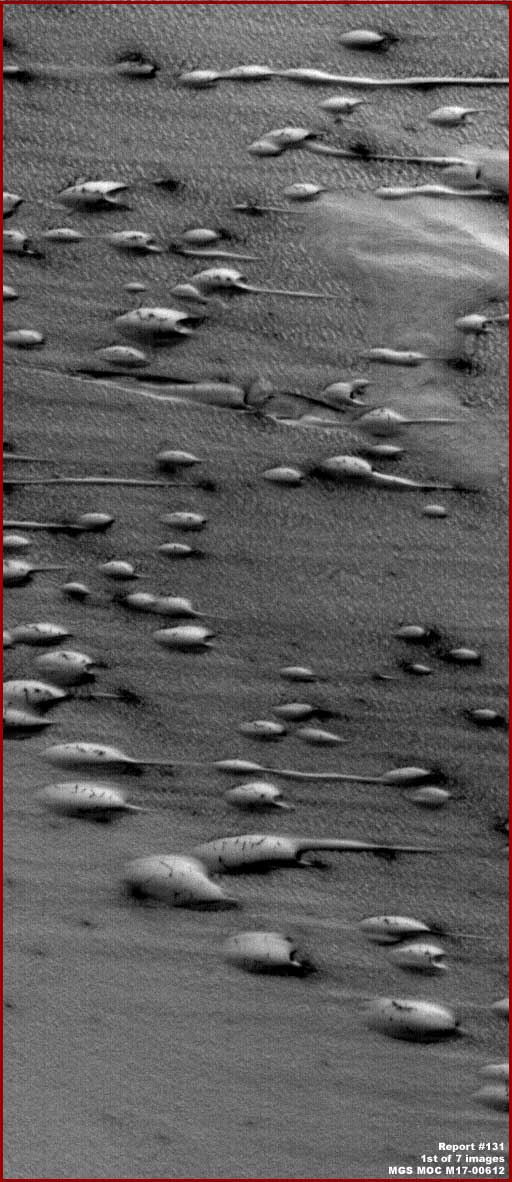
The above first image is from the upper portion of the very long official MGS MOC M17-00612 narrow-angle straight .GIF strip. The view is the full size as the strip is officially presented and from one side edge to the other which the image stats say is 1.66 km or 1.03 miles across, although I wouldn't place too much confidence in those stats if I were you.
Although it doesn't appear so at first glance, this strip's resolution is very compromised. Normal size detail is very blurry and fuzzy and thoroughly obfuscated. That has severely impacted the normal size vegetation that is carpeting the ground here to the point that the vegetation isn't recognizable. However, that is not part of the reporting here. The reason that the scene still looks pretty good on the surface is because the light color objects seen are very large and over coming the resolution limitations to some extent. Remember this principle as you view the rest of the evidence from this strip.
Truthfully the above scene doesn't have all that much to do with the "strange" theme of this report. I'm including this scene here simply because this type of evidence is present in this strip, you probably should be aware of it, and it is convenient for me to include. This evidence exists in the Chasma Boreale locale which is the largest by far dark canyon extending deep within the North Polar Cap main body distorting the entire shape of the Cap which can be seen in the last image in this report. The objects you see above are present in great numbers and in a great variety of shapes and sizes within this Chasma general location.
The official interpretation of the many light color objects would no doubt (as usual) be that they are sand dunes. They aren't that but what they are is a mystery. In the Chasma they normally appear in large numbers and as isolated objects not part of and distinct from any readily apparent loose sand matrix. That is why the resolution in this strip is compromised to primarily affect the background making it fuzzy and indistinct forcing any vegetation present to be blurry enough to merge and look a little like sand that could produce sand dunes. These objects are always in some aerodynamic shape oriented in the same direction and they can be much larger than what you see above as well as smaller. Take a look at more of these objects in my 2006 Report #099 and especially the 1st, 2nd and 6th images there.
These objects appear to be cohesive and resistant to strong external forces. That is just as well because some of the terrain in the Chasma where they are located most shows distinct signs of very strong rapid shallow and broad area liquid flows across its top surfaces encountering these very resistant objects and eroding the terrain around and behind them in ways more powerful than and not consistent with strong wind forces alone. These objects also sometimes string out in a long line but regardless of shape always oriented in the same direction as all the other objects. It also appears that they can join one with each other and also loose their cohesiveness (death?) but either is very rare.
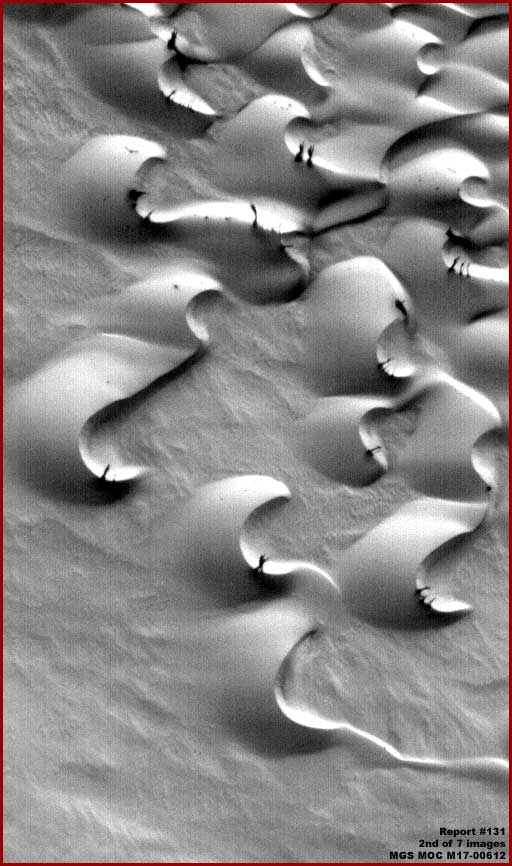
The above second image is from the lower portion of the same very long official MGS MOC M17-00612 narrow-angle straight .GIF strip. Again the view is the full size as the strip is officially presented and from one side edge to the other.
As you can see, the "dune" looking objects here are larger and, when they get larger, they often begin to take on this particular broad more pronounced aerodynamic shape or much more rarely the strung out in a long continuous line shape. However, it isn't the large light color objects I'm pointing out here but the smaller dark objects you see on them alway on the highest ridge point. Please note that the smaller dark objects are clearly vertically upright and take special note that they generally all are located at the same ridge spot on the larger base mass. Normally my natural reaction would be to assume that we are looking at the beginnings of some kind of dark growth and it may be that, but that consistent placement gives me pause.
I have to at least raise the question of whether we are looking at something extending or protruding from the underlying mass? Take a look at the closer views below of interesting sample evidence.
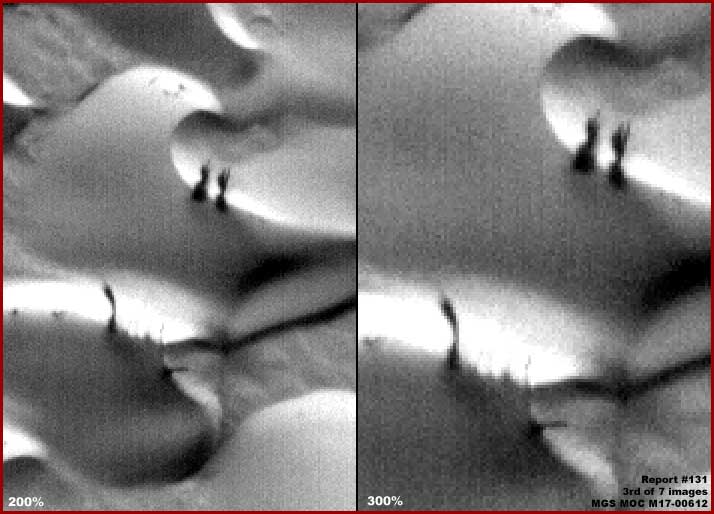
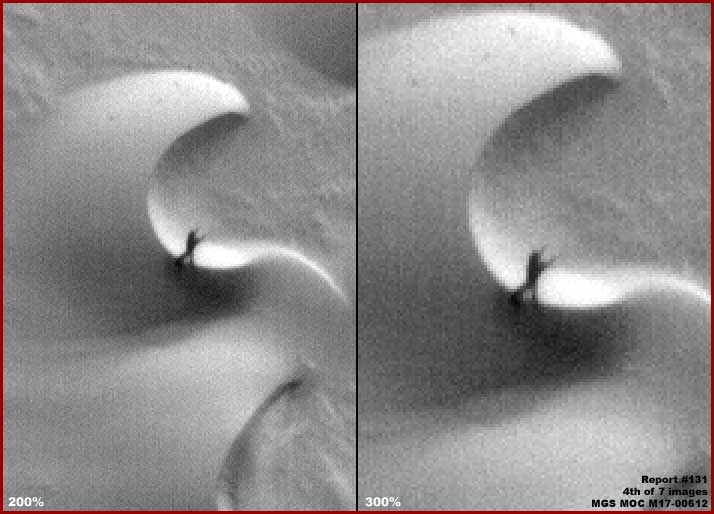
Obviously the dark evidence in the above fourth image looks a little like some bipedal being with two arms raised in supplication in the direction of the Sun. I have no idea what is going on here but I suspect this is just a chance configuration of this distinct vertically upright dark material resembling living bipedal anatomy. Also, remember that normal size objects take a visual beating in this imaging and the above strange looking dark evidence therefore is actually very large to be seen at all here.
Of more curiosity to me is why this dark upright material is located at this same spot on each of the formation and whether this material is a growth on the mass or a projection extruding from the underlying mass? As usual, plenty of questions but no satisfactory answers. Now lets move on to the next and quite different subject matter of this reporting

The above fifth image is from the different MGS MOC E15-01378 narrow-angle straight .GIF strip. The view is the full size as the strip as officially presented and from one side edge to the other, which the image stats say is 3.44 km or 2.14 miles across. Again, anything that we would consider normal size will be obscured in such a poor resolution image and only huge objects can be seen adequately.
Even though this site is well within the North Polar Cap main body, note how dark and light absorbing everything here is with no highly reflective snow/ice. In the fourth listed straight .GIF strip this evidence was drawn from there is actually very bright sunlight reflective Cap snow/ice terrain in the top of the strip. In fact it and this general site is very nearby if not adjacent to the evidence in my Report #127 titled "Mars North Pole Bio-Engineering" with evidence here just a little more distantly seen. In fact, a little of the above evidence can be seen there in the official strip but not shown in that report's imaging. Also, this evidence is in the same locale as my Report #130 titled "Mars Strange Evidence-1."
As one moves down this E15-01378 strip from the top, one moves across some super bright level Polar Cap material, across the barrier band/tube evidence in my Report #127 bathed in that bright light, up a terraced slope also bathed the reflective light, and onto the higher ground where this darker evidence is located away from the Cap material very strong reflectivity. You should also be aware that I suspect that the terrain to the right in the strip and to the right in the above image is falling away down hill.
I can't show you all this here because the graphics software is counting a great many large objects down there resulting in the above image, even though considerably compressed, being the largest file size that I've ever presented in this entire evidence record by far. So there is just no room for a view of enough inclusive evidence here without splitting up the report.
You can bet that the official interpretation of the above unusual looking evidence would no doubt be that it is simply sand dunes. Certainly it does resemble dunes just a bit, although some strange looking ones, and so that may sound plausible to some. I must add here that this evidence looks like no sand dunes I've ever seen on Mars out of many thousands of images. The problem is that the dune explanation just doesn't hold well under closer more careful scrutiny even considering that this is another world. Also, remember that very high image file size. That strongly suggests that there are a lot of individual objects down there and the software doesn't behave like that in the presence of real known dune shapes.
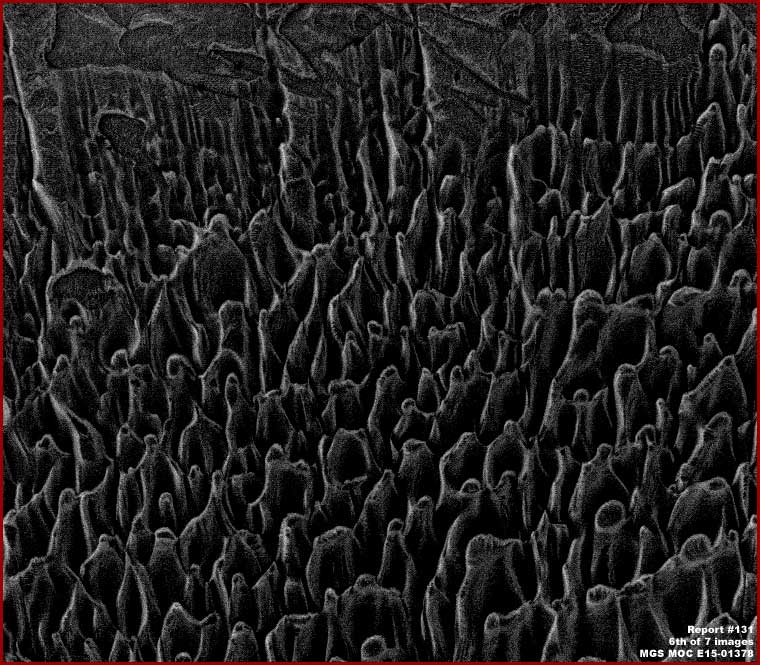
The above sixth image from the same MGS MOC E15-01378 strip demonstrates a portion of the same evidence in the fifth image at the same resolution but here rotated 90º counter clockwise. As you can see, in this view it begins to be more understandable why the software is counting so many upright objects down there. If this is the correct orientation as suggested by the software and I believe that it is, there are a lot of very large very upright objects down there and you'll note that they no longer resemble dunes either.
Remember that this evidence, although well within the North Polar Cap perimeter, is up on a rocky mount rather than a part of the Cap regular snow/ice surfaces. Also keep in mind that the terrain in the top of this rotated image is likely fairly rapidly falling away via rocky terraces to eventually encounter the Cap snow/ice terrain far below this point. Finally, get your eyes up very close to the screen and examine this evidence very closely and you will see that its surfaces are most often covered by unmistakable mossy bushy textured evidence that very much resembles life.
In fact, I think that we are looking at the correct orientation in the above sixth image and that we are seeing some very strange unknown living evidence adapted to the cold Polar environment. We can't be conclusive about this from just this image but it is so strongly suggestive to the point that it just can't be ignored. Further, when you look at the entire strip and take note of what the true super highly solar light reflective Polar Cap surfaces nearby really looks like in full sun reflecting strongly even up this mount's slope, you will realize just how dark and light absorbing the above evidence really is providing a strong clue that this is life trapping and absorbing solar energy.
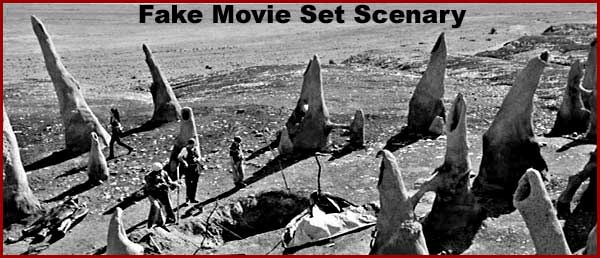
Courtesy of The Rhiana Griffith Fan Club
As you can see in the above image from the movie "Pitch Black" and the fake movie set material upright forms, there is a resemblance although the movie fake forms obviously aren't as densely packed. Then there is the image below that isn't fake material.
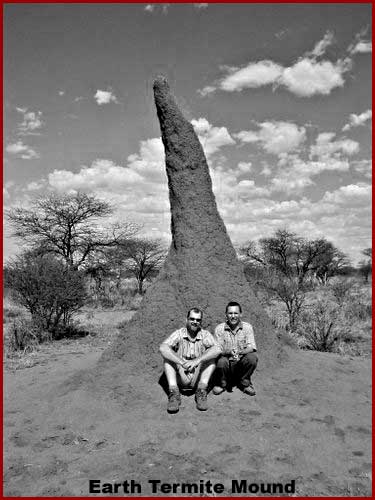
Courtesy Columbia News Service
As you can see in the above image, some Earth African (Namibia) termite mounds can also be a little suggestive of this Mars evidence. This just demonstrates that life, in this case Earth termite insect life, can utilize and transform otherwise natural geological soil material into vertically upright shapes that one would not normally expect to see it in. In other words, we are seeing geological material only but it represents life (termites) even though the resolution here, as close and good as it is, is also too poor to be able to see any termites even had some been out on the mount's surfaces. Further and notably, this vertical orientation in the above image is defying stronger Earth gravity as compared with the easier Mars gravity.
Now I have no conclusive knowledge as to what we are looking at here in the above sixth image Mars evidence but I suspect it is something living or something having to do with life despite its cold Polar Cap environment. If you will look very closely in the sixth image, many of these objects are covered with what definitely appears to be relatively short very plentiful busy projections. This secondary evidence may be a part of the objects or it may be something else like opportunistic plant life growing on the objects.
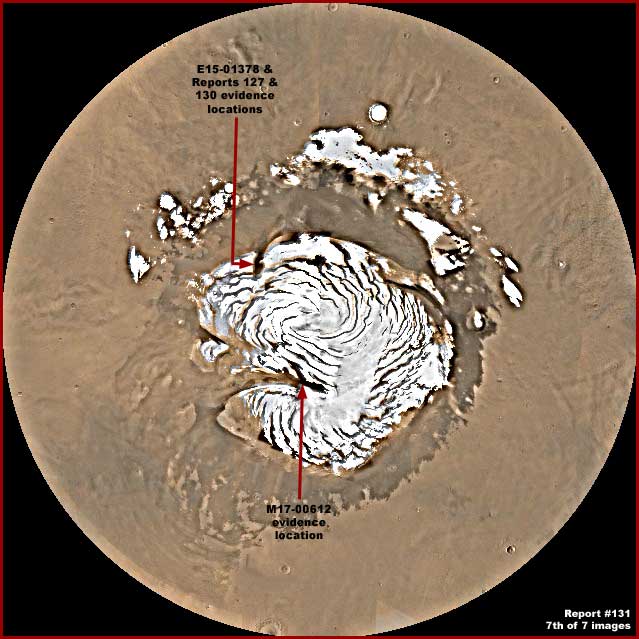
The above last image in this report is a global view of the North Polar Region with the North Polar Cap in the center area. The red arrows point out the location of the two different evidence sites in this reporting.
The bottom site darker area pointed out with the red arrow where the first presented evidence here in this report is located is within Chasma Boreale which, as you see, is a huge depression that extends deep into the Cap interior and even distorts the shape of the Cap. Some of the terrain in this Chasma appears to demonstrate evidence of strong periodic shallow liquid broad flows across some of the Chasma ground surfaces likely ultimately exhausting out the Chasma opening to the left that also likely contributes to its tapered widening there, build up of sediment there, as well as the absence of Polar Cap highly light reflective snow/ice there.
The upper site dark area pointed out with the other red arrow where the second presented evidence here in this report is located is an area of both level terrain usually covered by Cap snow/ice as well as spotted large darker color light absorbing depressions, but also darker color solar light absorbing mount heights. The strange looking upright formations shown in this reporting are found on the heights.
You should know that I suspect Cap snow/ice melt water periodically exhausts out from the Cap into the surrounding more open terrain at the Cap perimeter in locations like these and others creating conditions more favorable for life in these environs around the outside perimeter of the Cap. On the other hand, I suspect that temperatures on and around the North Pole is colder than at the South Pole and the surrounding terrain is much drier in the relative sense producing less standing surface water. That translates into a tougher environment for life to successfully exist in and necessitating adaptation extremes if it is to do so.
I do see a lot of forest life in these North Polar environs but it is often different than that around the South Pole. Also it is generally smaller in size and likely something unique to Mars that specializes in surviving the colder environments. Because of that finer texture and the poor resolution imaging, this evidence is much more poorly seen and harder to identify in this seriously compromises imaging as it has been publicly released. That is why I don't present this evidence unless it does come through larger and strong enough for the average person to stand a good chance of recognizing.
On the other hand, insulating massive size life is another survival tactic that might be anticipated in such colder tougher environs. That is one reason why I strongly suspect the colossal size evidence in my Report #125 titled "Mars Dunes or Mega Life" is in fact life of some unknown kind utilizing and reshaping geological soil material to suit its needs. This evidence definitely tends to concentrate in the more open terrain just outside the Cap exhaust openings such as the ones pointed out here by the red arrows in the above North Polar image. I suspect this colossal evidence requires occasional water infusion to survive but normally must have stable drier soil conditions and for that reason they are not found in the much more often wet South Polar region.
So we've wandered all over the place here and encountered some strange Mars evidence without being conclusive as to what it may be. Just give it some thought as to what you think it may be.
DOCUMENTATION
http://www.msss.com/moc_gallery/m13_m18/images/M17/M1700612.html: This link takes you to the official MGS MOC M17-00612 narrow-angle science data. My 1st–4th images were sourced from the third listed straight .GIF strip.
http://www.msss.com/moc_gallery/e13_e18/images/E15/E1501378.html: This link takes you to the official MGS MOC E15-01378 narrow-angle science data. My 5th and 6th images were sourced from the fourth listed straight .GIF strip.
http://www.msss.com/moc_gallery/s05_s10/mc01.hrml: This link take you to the official MGS MOC North Polar global image that my last report image was sourced from.
, Investigator
![]()